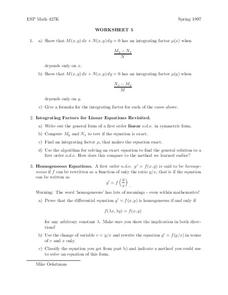Curated OER
Creating a Bar Graph with a Graphing Program
Students use the S'COOL data base to create a bar graph.
Curated OER
Functions in Motion
Students graph polynomials functions and analyze the end behavior. In this algebra lesson, student differentiate between the different polynomials based on the exponents. They use a TI to help with the graphing.
Curated OER
Graph Related Linear Inequalities
High schoolers explore the concept of linear inequalities. In this linear inequality lesson, students graph linear inequalities using Microsoft Excel.
Curated OER
Inverse Variation
In this algebra worksheet, students find the inverse of an equations. They graph their solutions and analyze it. There are 8 questions.
Curated OER
Worksheet 5
In this math worksheet, students review integrating factors for linear equations. Then they read about the definition and solving of homogeneous equations.
Curated OER
Function Tables
Students practice representing problems found in the real world in terms that can be translated into mathematical expressions. The situations are represented in tables and graphs by students.
Curated OER
Determination of Phylogenetic Relationships Using Restriction Analysis
Students applied various mathematical analyses to interpret their data. By using the resulting DNA fragment patterns from several enzymes students established a possible evolutionary relationship among the mice.
Curated OER
Handling Data: Probability, Chase Me game
Students participate in a simulation in which the aim is for the tortoise to catch up with the hare or vice versa. Moves are decided by throwing two dice. Adding together the numbers on the two dice tells you which animal moves one...
Curated OER
Graphing Linear Equations Using Data Tables
Students review the Cartesian plane and the process of plotting points. In groups, students create tables, identify the slope and y-intercept, and graph the equation. Afterward, students perform the same process, only, individually. As a...
Curated OER
Linear Equations Data Tables
Students graph linear equations on a Cartesian plane. After describing data tables and their use, students explore how the information from a table can be used to create a line graph. They discuss reasons for plotting a minimum of...
Curated OER
Worksheet 18 Fall 1995
For each of the equations they find the values of the rational expressions. Then they differentiate each expression in relation to the value of t.
Curated OER
Worksheet 20 Fall 1995
In this math worksheet, students describe a step by step method to solve rate problems. Then they state the time derivatives of different quantities.
Curated OER
What are the Odds
Students predict the-outcome of an event. In this algebra lesson plan, students compare and contrast the probability of an event occurring. They calculate the odds of a simple event and make estimation.
Curated OER
Mathematics Within: Algebraic Patterns
Students discover patterns in linear equations by playing a dice game to collect data. They graph the data and analyze the patterns of the lines created by the data. The class then compares the individual graphs to evaluate the position...
Curated OER
Lift Equation Problem Set
Students, after reading an explanation from a NASA Web-based textbook, demonstrate an understanding of the text by using it, along with FoilSim, to complete an activity to graph and interpret the lift equation.
Curated OER
Ice Creams
Students list all the outcomes for single events, and for two successive events in a systematic way. When dealing with a combination of two experiments, they identify all the outcomes, using diagrammatic, tabular or other forms of...
Other popular searches
- Identify Dependent Variable
- Dependent Variable Worksheet
- Independent Dependent Variable
- Dependent Variable Math
- Dependent Variable, Math

















